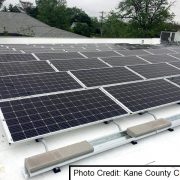By Brenda Schory
July 7, 2017
Read the original article Here
GENEVA – Riverbank Laboratories Inc. in Geneva installed a solar panel system that is expected to provide nearly all of the company’s electricity needs.
Company owner and president, 5th Ward Alderman Robert Swanson, said it was a step in the right direction for the environment.
“Every day, we are saving trees and keeping C02 emissions from going into the air – and it’s renewable energy,” Swanson said. “It’s not using coal or oil or natural gas that has a finite quantity.”
Carbon emissions from burning fossil fuels raise global temperatures by trapping solar energy in the atmosphere, according to the National Academy of Sciences, Engineering and Medicine website, nasonline.org.
Riverbank Laboratories, which manufactures and ships tuning forks, put on a new roof in April with installation of the solar system beginning soon after in May, company spokeswoman Mary Robinson said.
“Once you put the solar panels on, you do not want to take them off for a new roof,” Robinson said.
Rethink Electric, a Geneva company, performed the installation on the 6,500-square-foot roof, she said.
Swanson said he does not have solar panels on his house because large trees shield it from the sun.
“But it makes sense on a large, flat roof with no trees nearby,” Swanson said of his company building.
Since the panels went live May 31, they have produced enough energy to power 11,600 light bulbs for a day and saved 6,000 pounds of carbon dioxide from being emitted – the equivalent of planting 150 trees – Swanson said.
“It’s the right thing to do, reducing our carbon footprint,” Swanson said. “Our customers appreciate our commitment to the environment.”
The system is designed to produce more electricity than will be used in the longer, sunnier spring and summer days, Swanson said. Excess power generated by the solar panels will go back to the grid for use by others.
“We get credit for that shared power on cloudy days when we draw our electricity from the grid,” Swanson said. “Over the course of a year, we expect to generate 97 percent of our electrical power needs via our solar panels.”
Mike Nicolosi, owner of Rethink Electric, said he has worked in the solar industry for 11 years and started his company three years ago.
“They are stepping out and showing, ‘Why not get power from the sun than from coal or a nuclear power plant?’” Nicolosi said of Riverbank Labs. “With solar power, there is no turbine or machine or anything turning or making smoke. You are eliminating the amount of CO2. That is a feel-good thing.”
While everyone might not care about reducing their carbon footprint, Nicolosi said, most will care that the cheapest way to get power is through solar energy – not buying it from ComEd or even from Geneva’s own electric utility.
“The cheapest is buying solar,” Nicolosi said. “There is nothing cheaper.”
According to a report by the nonprofit foundation World Economic Forum, the cost of solar and wind generation has dropped so much that it is competitive against coal and natural gas.




